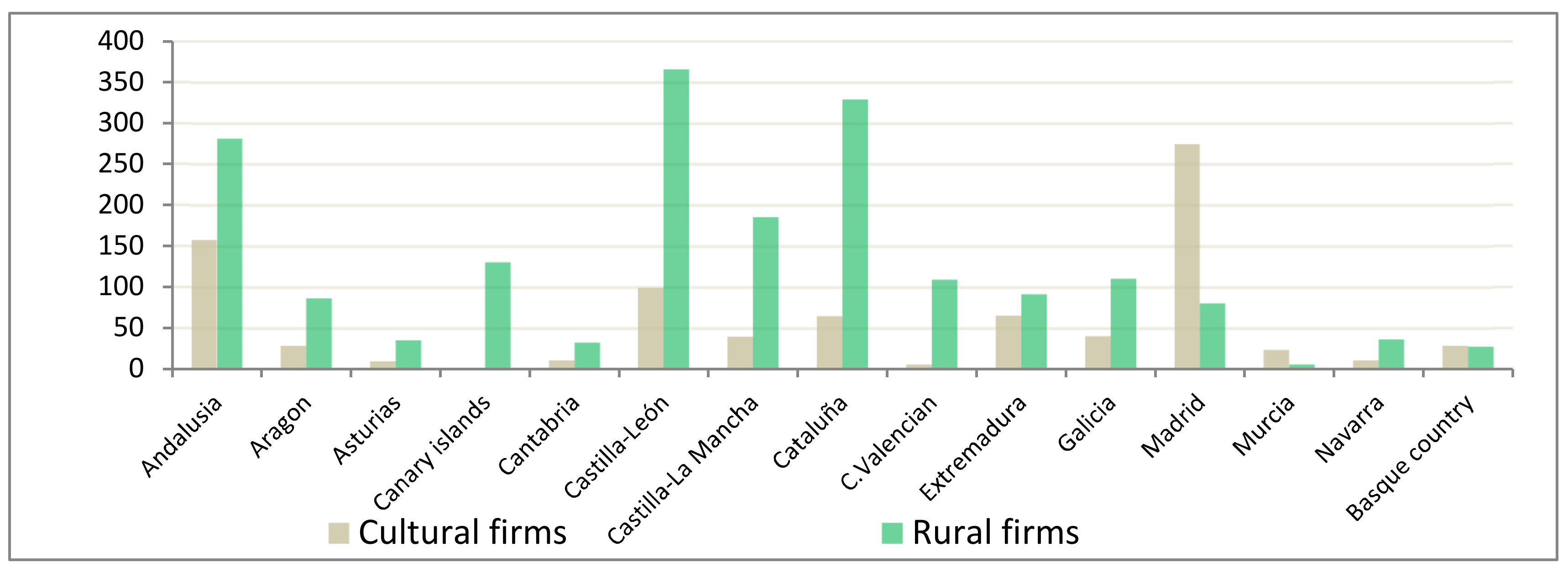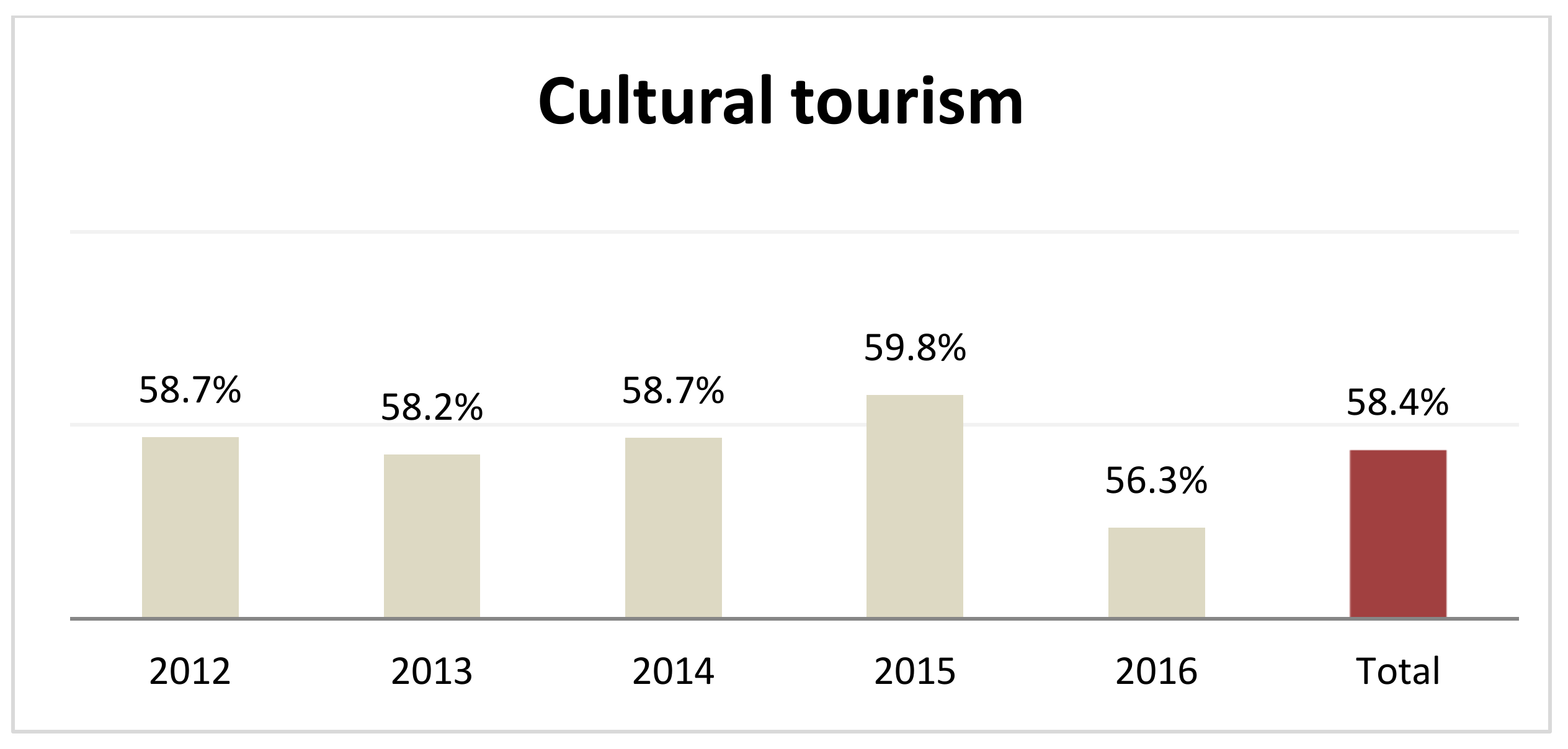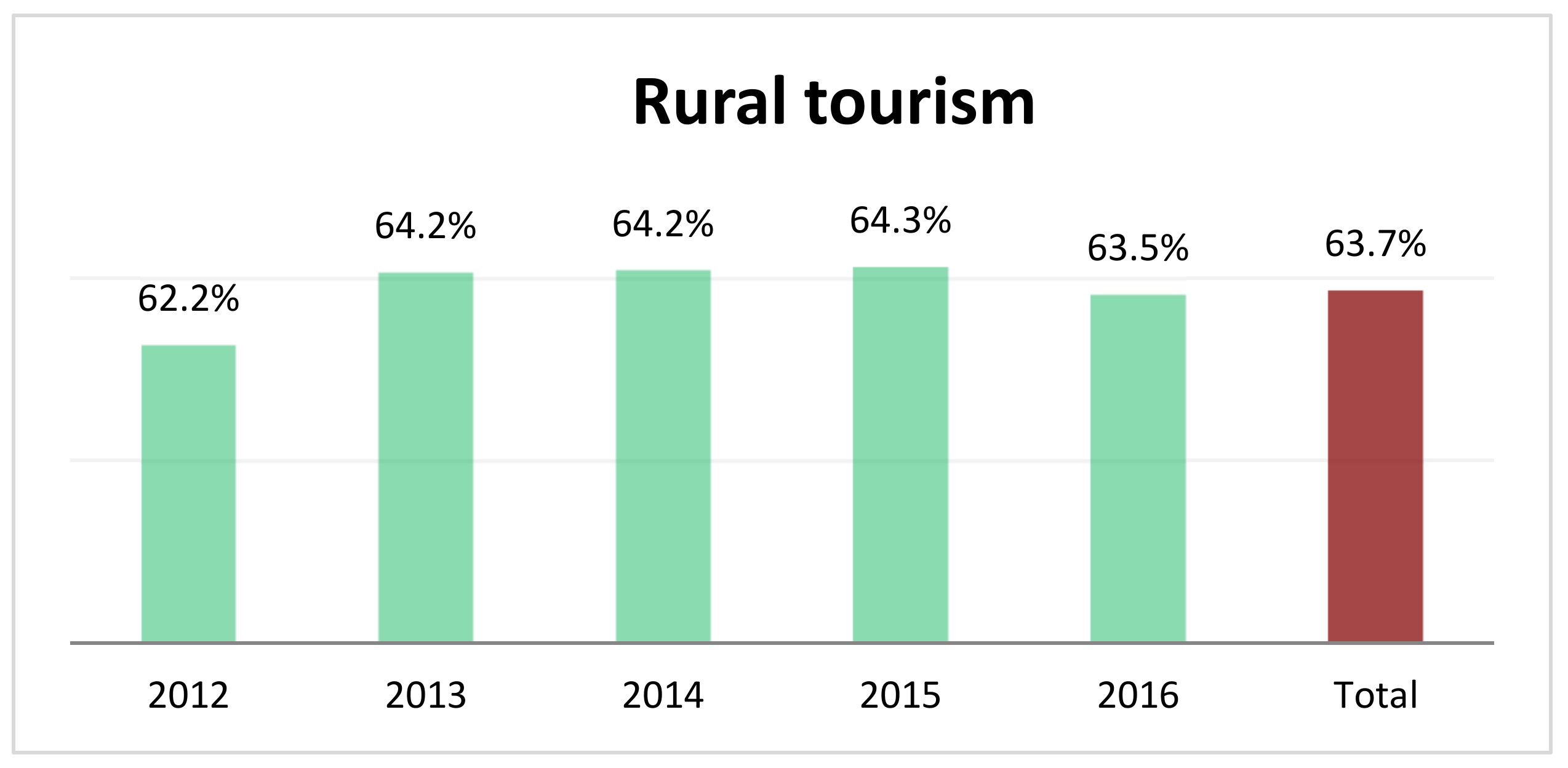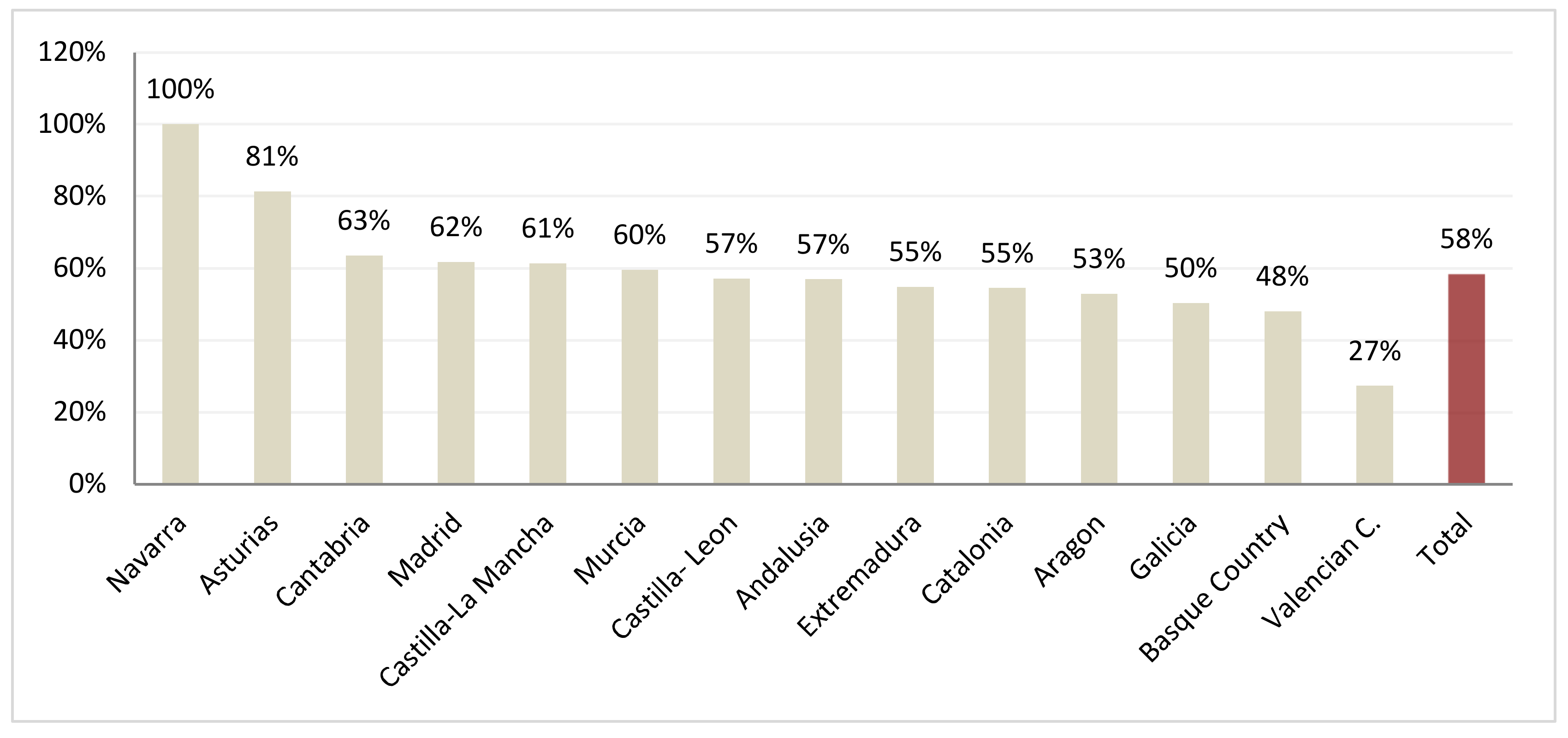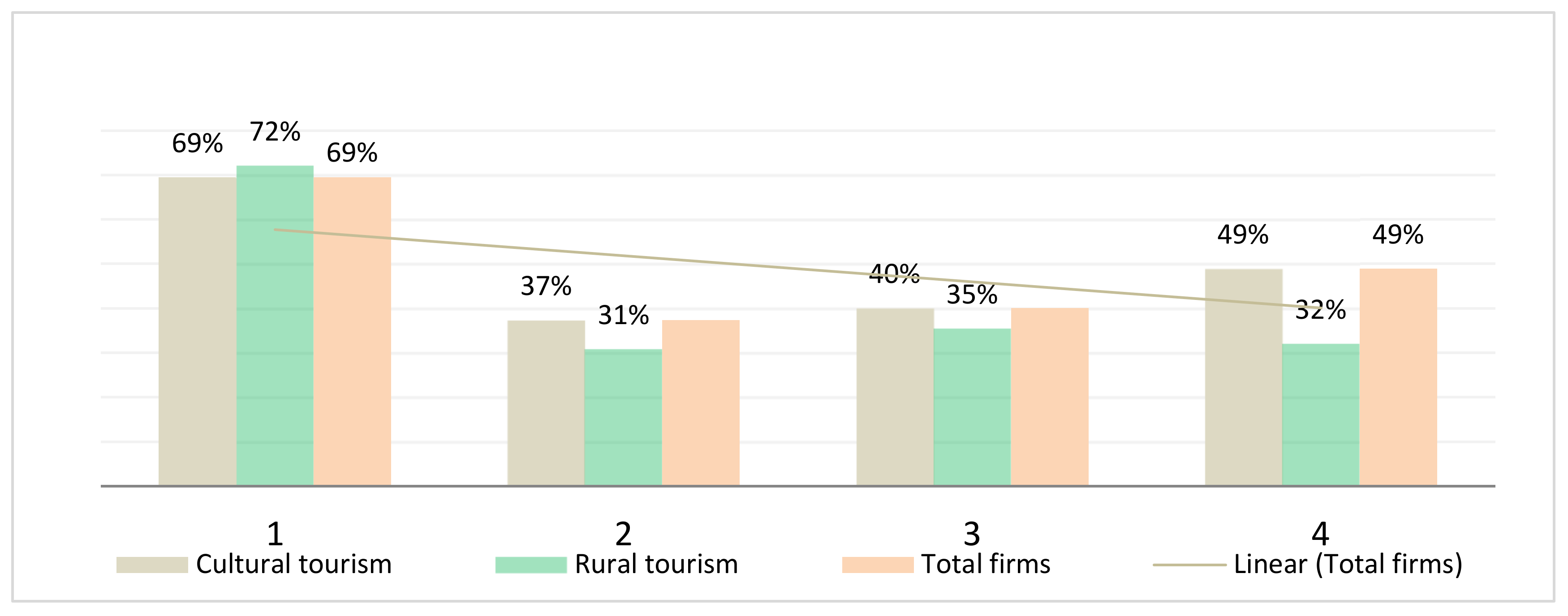2.1. Firm Efficiency with a Sustainability Perspective
International organizations and social demand require tourism businesses to be more responsible with the environment and its stakeholders [
27]. It is fundamental to reduce the global impact of tourism and travel, which accounts for 5% of carbon emissions worldwide: the reduction in costs and the increasing efficiency in the consumption of resources could improve the competitiveness of tourism firms [
28]. Hence, many clients of tourism services consider environmental and social responsibility as an essential part of the quality of a tourist destination, beyond the satisfaction of the service or the tourist experience.
Zientara and Zamojska [
29] focused on the environment and citizens’ organizational behavior in a sample of hotels in Poland. The evidence reveals that employee engagement and green organizational climate positively influence organizational citizenship behavior regarding the environment, but most hotels show weak organizational behavior which implies a lack of organizational emphasis on ecological practices. Quality standards require good environmental practices and prevention of environmental impact in tourism companies that will achieve a sustainable quality. Some companies have opted for an international distinctive “Cradle to Cradle” (C2C). This certification could allow companies to distinguish more environmental products and processes.
Specifically, C2C contemplates that the water, the energy and all the raw materials used in the construction and rehabilitation of a hotel can be recycled when the property is obsolete. Llorach-Massana et al. [
30] analyzed the C2C certification for the differentiation of environmentally preferable products. The authors also identified which types of C2C-certified products achieve a reduction in environmental impact. Although the investment is more expensive at the beginning, in the medium term, it is profitable and reduces costs.
C2C emerges as an alternative to the eco-efficiency concept based on life cycle assessment (LCA); however, both concepts are different. The main objective of eco-efficiency is to reduce the negative environmental footprint of activities, while C2C tries to increase the positive impact. Bjørn and Hauschild [
31] analyzed the strengths and weaknesses of both concepts (C2C and eco-efficiency based on LCA evaluation) and included some proposals to overcome the current limitations of these concepts. For example, they argued that the positive message and the simplicity of the C2C principles may be preferable in the context of small and medium-sized enterprises (SMEs) with limited resources. It remains a challenge to reduce the complexity of LCA as a tool in order to favor its accessibility without compromising its validity.
Energy eco-efficiency plans are also an opportunity for cost reduction; in addition to energy and water, it is important to reuse materials: everything that is used in an establishment must be recyclable [
32]. Circular economy is a challenge for all industries, including tourism firms.
Extended research has examined sustainable practices in the hotel industry from several perspectives: the implementation of voluntary environmental practices and strategies [
12,
13], or the potential benefits for firms, customers and the global hotel industry [
6,
12,
15,
18]. For example, Singal [
15] found that investment in environmental programs improves future financial performance (measured by the credit rating of the following year) in a sample of 16,325 US firm-years (624 firm-years correspond to hospitality and tourism firms) over the period 1991–2011. The results also reveal that hospitality tourism firms, on average, invest more in environmental programs and have marginally fewer environmental strengths (beneficial products and services, pollution prevention, clean energy and recycling, among others) and fewer concerns (emissions of toxic chemicals, noncarbon emissions and controversies such as noncompliance with regulations, climate change allegations, among others) compared to non-hospitality firms.
Zhang et al. [
13] focused on the implementation of voluntary eco-certifications in a sample of 2893 US hotel properties in the year 2011. The results show that eco-certified hotels achieved more operational efficiency and higher customer-driven resource efficiency compared to non-eco-certified hotels. The positive effect is sharpest in lower-tier properties because customer efficiency is most visible in these properties compared to upper-tier properties. Segarra-Oña et al. [
12] examined 2116 Spanish hotels that have adopted an environmental management strategy, measured by the implementation of the ISO 14001 standard. The evidence shows that the performance of urban and beach hotels with certification is different compared to hotels without certification. In contrast, the results do not remain the same for small rural hotels. In addition, the evidence reveals that size and organizational factors are drivers for performance. In an interesting study, Guix et al. [
25] examined sustainability reporting in a sample of 50 large hotel groups worldwide, considering the stakeholder-related practices. The results suggest that sustainability reporting is more related to a box-ticking or legitimization exercise than valuable information for stakeholders.
Several papers studied the relationship between efficiency scores and sustainable practices at the firm level or country level [
6,
14,
17,
18,
33]. Kularatne et al. [
6] explored the eco-friendly practices in day-to-day operations in environmentally sustainable hotels. They employed a double-stage DEA modeling approach analyzing efficiency indicators and the incidence of explanatory variables. They focused on three sustainable variables: energy-saving, water-saving and waste management practices. The results reveal that hotel efficiency is associated with energy saving and water saving. The main strength of the study is the inclusion of eco-friendly variables as efficiency determinants. Despite the limitation of the small sample size, the authors found a relationship between firm performance and sustainable practices. Managerial and practical implications for sustainable management confirm that initiatives aimed at the adoption of sustainable practices in hotel companies have a positive impact on hotel efficiency. However, Shahgholian [
26], focusing on a complete review of the literature, argued that the relationship between environmental performance and firm performance is not still clear because the data and methodology can infer the results and their replicability.
The hotel location and its relationship with sustainability practices provide an interesting research question. For example, Reid et al. [
14] examined the sustainable hotel practices in a sample of Asia-Pacific hotels, including three locations: urban hotels, coastal hotels and other hotels. Based on green building certification programs for two years and 594 sustainability practices, they found that urban hotels report a greater number of sustainable practices than coastal and other hotels, while coastal hotels, on average, report a greater number of sustainability practices in their award applications compared with the other modalities. Since sustainability practices and active adoption of sustainability practices produce economic benefits and are aimed at improving environmental impacts and sustainability results, the conclusions of this study support the evidence of other previous studies, for example, Segarra-Oña et al. [
12]. However, the evidence should be interpreted carefully and exclusively in the context of the sample analyzed in the paper: the case of the hotels that submit requests for awards in the Asia-Pacific.
The rapid growth of the tourism industry in some regions produces a great environmental pressure, promoting a conflict between environmental sustainability and the tourism economy. In the empirical context of Chinese coastal cities, Liu et al. [
17] developed their research with the aim of evaluating the quality of tourism sustainability from the field of efficiency analysis. They focused on the eco-efficiency of 53 Chinese coastal cities during the period 2003–2013. In the first step, the DEA model indicates that the tourism eco-efficiency of Chinese coastal cities is 0.860, which could be interpreted as there still being opportunities for improvement. In the second step, the tobit model indicates that the tourism eco-efficiency of Chinese coastal cities is positively associated with the economic and ecological indicators and negatively associated with the number of tourists and the use of three major pollutants in the tourism industry. Although the context of the study limits the possibility of generalizing the efficiency results to other regions and countries, a novelty of this study is that authors propose some eco-efficiency indicators based exclusively on two sets of input variables: environmental pollution indicators and resource consumption indicators (water and energy).
Considering an international perspective, Radovanov et al. [
18] used a DEA model and a tobit regression model to assess sustainable tourism development at the country level using a sample of 27 EU countries. Specifically, the authors proposed an efficiency analysis at the macroeconomic level of countries. The evidence shows high efficiency indices in 15 countries and that factors such as sustainability of tourism development, share of GDP, tourist arrivals and inbound receipts contribute to increase efficiency. A novelty of the study is the investigation of the efficiency of sustainable tourism development at the international level (Western Balkans) and comparison of the results with the EU countries. However, taking into account the sample and the high sensitivity in the frontier methodologies, these results should be interpreted exclusively in the empirical context of EU countries: a different selection of variables and changes in the characteristics of the database could result in different conclusions.
Using a macroeconomic perspective, Lacko and Hajduová [
33] identified a set of drivers that could be linked to environmental efficiency in a sample of EU countries. These authors pointed out that factors related to climate change and socio-economic factors are strongly associated with environmental efficiency and allow achieving a more sustainable growth in European countries. The main results also confirm the possibility to estimate the efficiency with DEA at the macroeconomic level, for example, using a sample of EU countries. In this case, it could be interesting to develop clusters, with the aim of individually implementing, in each country, specific measures to achieve all of the environmental objectives in the EU. The harmonization of public policies, considering cross-country factors and each jurisdiction, is essential to achieve sustainable growth in the EU that is compatible with environmental commitments.
While firm sustainability initiatives and strategies are increasingly being promoted in the tourism industry by different agents, the firm efficiency of sustainable practices is a crucial research question. In this paper, we focus on two tourism modalities: cultural tourism and rural tourism.
2.2. Cultural Tourism
Several studies analyzed the economic and social impacts of the tourist models that emerged after the traditional sun and sea model. The sun and sea model is not sustainable in many areas due to inadequate and inappropriate planning and a high number of buildings, in addition to the greater environmental impact on the landscape and coasts. In contrast, cultural tourism and rural tourism are alternatives and destination models that could positively affect sustainable and regional development in cities, villages and municipalities, with less environmental impact compared to other tourism models [
7,
9,
34]. Cultural tourism is an interesting modality, as we explain below.
According to Richards [
35], the “emergence of cultural tourism as a social phenomenon” dated post-World War Two was motivated by travel and people’s movements. The 1960s and 1970s was characterized by an increase in national and international travels and improvements in the consumption of culture. Later, the 1980s allowed consolidating international tourist flows in the major sites and touristic areas, creating an interesting and valuable market [
35]. In this decade, academia began to pay attention to the concept of cultural tourism and the UNWTO also established a definition for cultural tourism as a touristic model linked to the knowledge of monuments and historical-artistic places.
Cultural tourism has a positive effect on historical-artistic places, contributing to the maintenance and protection of cultural heritage and the sustainable development of many regions. Bec et al. [
36] proposed a conceptual model of heritage conservation in four stages for digital tourism experiences. The authors demonstrated that the integration of history with technological innovations has the potential to preserve and manage heritage, as well as enriching visitors’ experience and their commitment to history. Bui et al. [
37] analyzed cultural heritage destinations, focusing on: (i) defining the adaptive renewal cycle, (ii) analyzing the community’s resilience to the spatial-cultural changes of mass tourism, (iii) identifying the characteristics of tourism systems through the control mechanisms of social interactions.
This form of tourism justifies the efforts of maintenance and protection of cultural heritage due to socio-cultural and economic benefits for the regions [
38]. The distinctive element in cultural tourism is the approach to local culture, as a differentiated activity of mass tourism. Cultural tourism is a way of contacting the past and protecting it [
39]. In this context, the first research on the tourism and culture phenomenon was developed [
40,
41]. In 2005, the UNWTO observed that the cultural tourism model was being consolidated and, consequently, the following definition was proposed: “the set of people movements to meet the human need for diversity, aimed at raising the cultural level facilitating new knowledge, experiences and meetings” [
42]. Nowadays, the UNWTO define cultural tourism as: “a type of tourism activity in which the visitor’s essential motivation is to learn, discover, experience and consume the tangible and intangible cultural attractions/products in a tourism destination” [
43].
In relation to displacement, Richards [
41] conceptualized cultural tourism as people’s displacement from their usual residence places to cultural interest places with the aim of collecting new information and experiences that meet their cultural needs. Currently, cultural tourism has a broader connotation, since any tourist destination has a particular culture that can motivate tourist movements. Zhang et al. [
39] analyzed tourist consumption in intangible cultural heritage destinations and showed that cultural identity has a positive effect on heritage tourism activities. Seyfi et al. [
44] explored the factors that contribute to the experience of cultural places and destinations based on a theoretical model of cultural tourism experiences. The authors concluded that there are six key factors that affect cultural tourism experiences: prior knowledge, authenticity, commitment, cultural exchange, culinary attraction and quality of service. In cultural tourism, a crucial issue is the educational interest and the demand for a mental response that develops the active use of the mind [
45].
The competitiveness and efficiency evaluation of cultural destinations have been addressed in several papers [
21,
22,
23]. Guccio et al. [
21] examined the influence of cultural participation on tourism destination performance in a sample of Italian regions for the period 2004–2010, using the conditional efficiency approach to control the inference on the role of environmental factors. The results support the importance of cultural participation, that is, a more culturally friendly environment (both pure cultural and leisure activities) positively influences tourism destination performance. The managerial implication of their study is that public policies in cultural settings could be key drivers of efficiency in tourist destinations. Prior results in the efficiency literature show a positive relationship between the cultural environment and the efficiency in tourist destinations (for example, [
46], in a sample of hotels and French regions).
Herrero-Prieto and Gómez-Vega [
22] focused on the efficiency evaluation of tourist destinations in Spain, considering the regions as territorial units, and considering cultural tourism and tourist flow to be optimized. In the first stage, the performance was calculated through non-parametric methods, and in the second stage, the efficiency determinants were examined, including indicators representing reputation, accessibility, the omnivorous nature of cultural tourism and the scope of the regional cultural sector. Figueroa et al. [
23] considered the efficiency evaluation of tourist destinations in Chile over the period 2009–2014. Similar to the previous study, regions were considered territorial units and tourist flow was considered as the variable to be optimized. Using a two-stage model, the DEA model estimated, in the first stage, accommodation capacity and other tourist resources as the main input and tourist flows as the output. In the second stage, they examined the role of cultural resources using bootstrap techniques and truncated regression models.
Prior literature has also focused on the efficiency assessment of cultural spaces or institutions such as museums [
40,
47], libraries [
48] and cultural heritage agencies [
49]. Several papers used DEA models in the first step to evaluate the performance of these cultural institutions. For example, del Barrio-Tellado and Herrero-Prieto [
47] evaluated the efficiency of 23 museums in Spain through a non-radial approach using a DEA slack-based measure (SBM) network and a truncated regression model to evaluate the efficiency determinants (accessibility, tourism capacity, cultural appeal, museum age and the institutional management model). Prior efficiency analysis in cultural spaces such as museums has taken into account, as input and output variables, all museum activities without considering the interrelationship between the museum activities. The application of DEA SBM network models allows including the relationships between different activities. Finocchiaro-Castro et al. [
49] examined, in a first step, the efficiency scores of the conservation activity of nine Sicilian heritage authorities during the period 1993–2005 and, in a second step, the discretionary and non-discretionary variables related to economic, political and managerial factors. Although a small sample size could condition the results obtained in the levels of efficiency, the conclusions of the research could be useful in the design of public policies as well as in the allocation of resources in the context of cultural heritage.
The UNWTO Report on Tourism and Culture Synergies [
43] revealed that 89% of national tourism administrations are related to cultural tourism. Furthermore, an increase is expected in the following years. The report also pointed out several challenges for academia: the definition, synergies between tourism and culture, profitability or economic benefits, governance planning, the application of new technologies to cultural tourism experiences, etc. Therefore, the efficiency of this tourism modality is a crucial research question.
2.3. Rural Tourism
Rural areas are historically based on the development of agricultural activities and their importance in economic activity has been progressively reduced. The agricultural model has lost importance and many rural areas have been restructured. Lane et al. [
50] analyzed the evolution of rural tourism as an alternative tourism model and a tool for rural regeneration and conservation. Tourism is a major economic activity that has the greatest potential to generate new sources of wealth and employment, improving the economic decline in rural areas. Therefore, rural tourism emerges as crucial tool to achieve long-term sustainability of rural tourism destinations [
7].
Rural tourism is an activity that takes place in rural and natural areas, although there is not a unique or acceptable definition [
51]. The basis of this tourism is the rural environment, which includes natural, historical-cultural and architectural heritage in a broad sense. Among the reasons that make tourism activity an important driver of rural development processes are: its ability to energize and diversify the economies of rural areas; its value due to the natural and socio-cultural heritage of these areas; and its contribution to increasing the size of the local market as a result of the increase in consumer demand made by visitors [
11].
The development of tourism in rural areas positively contributes to the improvement of their economies, acting as a complement of other types of successful business. Rural tourism not only provides income for the owners of rural establishments but also generates multiplier effects towards other productive activities, such as restaurants, bars, small businesses, construction and agricultural and artisanal productions. In rural tourism, the role of SMEs and microenterprises is extremely important, since many businesses are very small and managed mostly by individual owners or families. This aspect contributes to local entrepreneurship in rural areas. Indeed, many rural destinations are interested in considering this activity among their socio-economic development strategies. The need to diversify other types of tourism such as the sun and sea, considering a more sustainable tourism that conserves the natural and socio-cultural resources, has also motivated a growing tendency in recent decades around the world, although each country has a different growth and tendency.
The competitiveness, assessment and monitorization of rural tourism destinations with a sustainable perspective have attracted the attention of academia, professionals, local communities and governments. The existing literature suggests that competitiveness is conditioned to factors such as activities and recreations in natural areas [
11,
19], tourist facilities and tourist infrastructure [
11], the collaboration and networks among firms to enhance and promote strategies [
52], tourist loyalty [
3], psychological dimension variables [
7,
53] and local governments and municipalities as facilitators of the process for the development of rural tourism [
52,
54].
The high competitiveness of tourism markets leads managers to reinvent tourism destinations, seeking sustainable competitive strategies and advantages. An important strategy to achieve sustainable advantages is related to the promotion of tourist loyalty. An understanding of how to build loyalty is a key aspect of competitive advantage. For example, Campón-Cerro et al. [
3] found that the image, the quality and destination attribute of satisfaction influence tourist loyalty, using a sample of 464 rural tourists and the partial least squares model. The main contribution of the study is the identification of the factors that contribute to promoting tourist loyalty in the empirical context of Spanish rural tourism. However, this empirical context and the specific characteristics of the database and the sample could make it difficult to generalize the results to other contexts and tourist destinations. Kastenholz et al. [
53] analyzed the experience of rural tourism through a scale of tourism experience. The authors identified the relevant factors in different dimensions: education, memorability and esthetics, among other aspects.
The development of sustainable competitive advantages in the hotel industry could be closely related to the image of the tourist destination. Leković et al. [
7] introduced a novelty in the study compared to the previous literature in rural tourism by analyzing the components of the cognitive image in the rural tourism destination. They examined three factors related to functional, mixed and psychological components using three methodologies: exploratory factor analysis, confirmatory factor analysis and structural equation modeling. The evidence shows the importance of the cognitive component for the development of rural tourism destinations. Developing an appropriate image can further achieve sustainable strategies in the hotel industry and also in a particular destination.
In an interesting study, Gonzalez-Ramiro et al. [
19] focused on identifying the potential factors that contribute to the development of tourism activities in rural areas. Based on six factors: tourism accommodation offer, activities in natural areas, gastronomic offer, cultural activities, bath offer in natural environments and activities in active tourism, they hierarchized the main factors and proposed a detail decomposition. Hernández-Maestro and González-Benito [
54] evaluated different financing programs for the development of business activity in accommodation, considering rural tourism establishments. The authors identified the determinants of business success in these establishments for both companies and entrepreneurs. The type of product or service, knowledge and promotional tools are relevant factors for business performance measured by variables such as occupation, prices, sales and profits.
Other research focused on the assessment of different rural tourism firms and destinations and also the efficiency determinants or drivers [
20,
55]. Guaita Martinez et al. [
20] analyzed the impact of the seasonality of rural tourism in comparison with other types of destinations in Spain. In particular, they examined three coastal and urban destinations in Spain. Previous studies that have examined the seasonality in tourist destinations generally used concentration indices of tourist flow variables (e.g., flow of visitors). Considering the seasonality measure, a limitation is that for each selected variable, the seasonality indicator is a partial indicator that could vary in terms of classification, making the practical application and comparability difficult. In order to overcome this limitation, Guaita Martinez et al. [
20] proposed, as a measure of the seasonality in tourist destinations, a synthetic indicator based on partial variables representative of the destination seasonality. The evidence shows that the intensity of the seasonality in rural destinations is not high and not far from urban tourism destinations: consequently, rural tourism generates stable profits year by year in the area. In respect to its contribution to sustainable development, the authors concluded that, in some cases, it improves the sustainable development of the area from economic, social and environmental points of view. Managerial implications in this study also indicate that rural tourism encourages a stable activity for regions.
In the field of efficiency in the tourism sector, DEA non-parametric frontier methodologies are frequently used to estimate the efficiency of tourism regions, countries and firms. This methodology allows analyzing efficiency by means of a synthetic index that is calculated with linear programming. Although there is a large body of literature oriented towards efficiency analysis in the hotel sector, the lack of studies that examine efficiency in the tourist apartment and short-stay accommodation sectors motivated the study by Alberca and Parte [
55]. This study was aimed at the indicated research gap, by analyzing the efficiency in the tourist apartment sector with microdata and a large sample of tourism firms. In order to analyze the efficiency indicators, the authors used different radial and non-radial DEA models to provide more robust findings. The main results show the most efficient regions and destinations, as well as the explanatory factors. The study provides interesting evidence for management and tourism policies that seek to improve destinations’ competitiveness: diversified destinations perform better that non-diversified destinations; and the diversification of tourist destinations, especially based on the cultural and rural touristic dimensions, is a useful strategy with a positive impact on the performance of tourism firms.
Overall, the assessment and monitoring of business performance in cultural and rural destinations with a focus on long-term sustainability emerge as a vital line of research. Although the prior literature has focused on certain factors that enhance or hamper the development of these tourist modalities and also competitiveness and business success [
20,
52,
54,
55], the evidence is still scarce.
